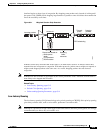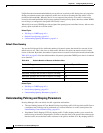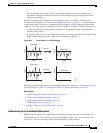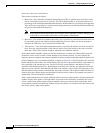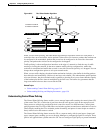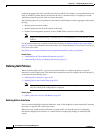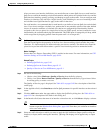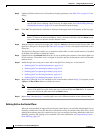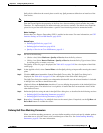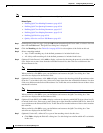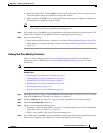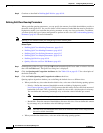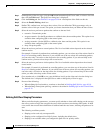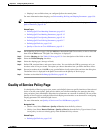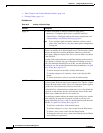
63-13
User Guide for Cisco Security Manager 4.4
OL-28826-01
Chapter 63 Configuring Quality of Service
Quality of Service on Cisco IOS Routers
QoS policies defined on the control plane override any QoS parameters defined on an interface of the
same device.
Note QoS is applied to packets on a first-match basis. The router examines the table of QoS classes starting
from the top and applies the properties of the first class whose matching criteria matches the packet.
Therefore, it is important that you define and order your classes carefully. The default class should be
placed last to prevent traffic that matches a specific class from being treated as unmatched traffic.
Before You Begin
Ensure that Cisco Express Forwarding (CEF) is enabled on the router. For more information, see CEF
Interface Settings on Cisco IOS Routers, page 59-24.
Related Topics
• Defining QoS Policies, page 63-10
• Defining QoS on Interfaces, page 63-10
• Quality of Service on Cisco IOS Routers, page 63-1
Step 1 Do one of the following:
• (Device view) Select Platform > Quality of Service from the Policy selector.
• (Policy view) Select Router Platform > Quality of Service from the Policy Type selector. Select
an existing policy or create a new one.
The Quality of Service page is displayed. See Table 63-3 on page 63-20 for a description of the fields
on this page.
Step 2 In the Applied to field, select Control Plane to define QoS policing on input traffic entering the control
plane.
Step 3 Click the Add button beneath the Control Plane QoS Classes table. The QoS Class dialog box is
displayed. See Table 63-5 on page 63-23 for a description of the fields in this dialog box.
The QoS Class dialog box enables you to determine which traffic over the selected interface is included
in the QoS class and how to handle that traffic.
Step 4 (Optional) Select the Default class check box if you are defining the properties of the default QoS class
for the control plane. The default class is assigned to all traffic that does not match the criteria of the
other defined classes.
Step 5 Define the QoS class using the tabs in the QoS Class dialog box, as described in the following sections:
• Defining QoS Class Matching Parameters, page 63-13
• Defining QoS Class Policing Parameters, page 63-17
Step 6 Repeat Step 3 through Step 5 to add QoS classes to the control plane. If required, use the Up Row and
Down Row buttons to reorder the classes.
Defining QoS Class Matching Parameters
When you define matching parameters, you must define matching criteria and specify whether packets
must meet one or all of the criteria to be considered part of the class. See Understanding Matching
Parameters, page 63-2 for more information.



